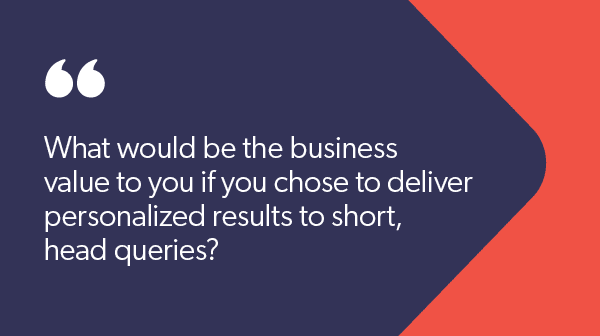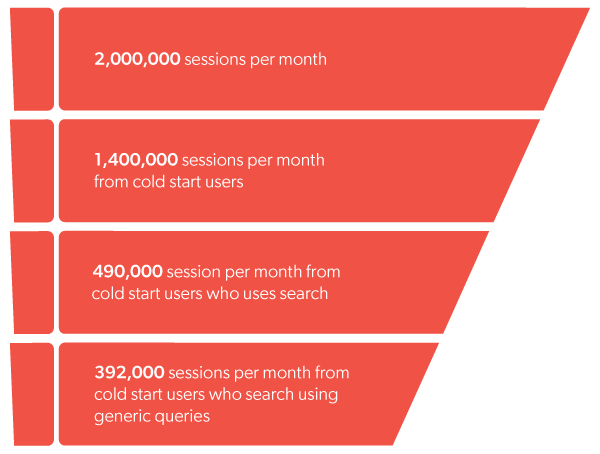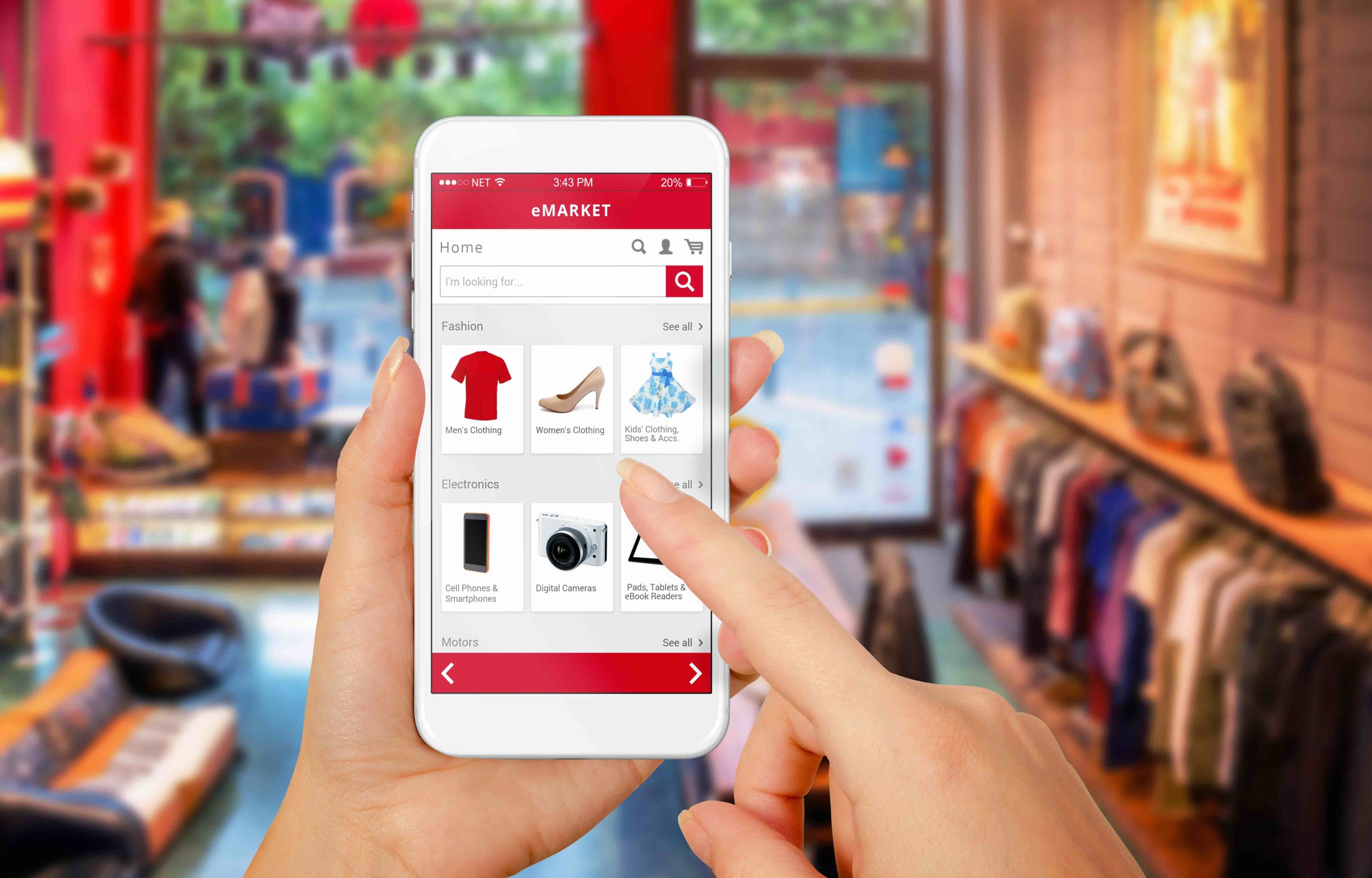Cold-start shoppers and “head” searches can increase your site traffic and revenue – as long as you treat each of them as jumping off points for personalization. Here’s why you need to consider this.
Cold-start shoppers make up 70 percent of site traffic — that includes genuinely new visitors who have never been on the site as well as those who are categorized as new visitors based on your tracking snippet.
This happens much more than you might imagine and might be triggered by:
- a shopper on your site in incognito or private browsing mode
- someone who visits your site initially using one device and revisits later on a second device without being logged into the browser on at least one
- a user who comes back after a three-year absence because Google tracking snippets account for a two-year time period
- a user who clears their browsers’ cache
The reality for most brands and retailers is that the overwhelming majority of visitors to their sites are new. That presents two big challenges: generic head queries and sparse customer data.
What are the Challenges of Working With ‘Head’ Queries?
Those new visitors to your site? Most of them are going to start with a search. Coveo’s research found that between 30 percent to 60 percent of visitors conduct an on-site search.
More importantly, those searchers are up to four times more likely to convert than visitors who do not search.
It would be easy if our new or rarely returning visitors told us exactly what they wanted when they went to the search box. Instead, they tend to use short head queries, which are broad and generic.
Most likely though, if you look at an ecommerce query log, you’ll find a hockey-stick-shaped Zipf distribution, named after Harvard linguist George Kingsley Zipf. He found that a few terms are quite popular, while many others are hardly used at all.
Importantly, the top 20 percent of queries drives a significant portion of traffic, But they also benefit the most from the ability to deliver tailored results, since they’re typically very generic.
This shouldn’t be surprising. If you are walking into a store for the first time you might wonder — do they have Nike shoes? So “Nike shoes” would be the head term. But asking that question and buying are still many steps apart.
For myself, I would want to know if they had them for men, a trail shoe, european size 45, and finally the color. So the head term is “Nike shoes” — and that question is asked about 2 percent of the time, according to our chart. But my real question is a very long tail (and rare) “Nike + trail shoes + men’s +size 45 +green.”
And I’m not alone. Our research shows that personalized results are 30 percent more accurate than non-personalized search results, which translates into substantial improvements in conversion rates.

How Can Retailers Provide Personalization Without Customer Data?
And here’s the rub: How do you offer personalization to someone you have never seen before?
In our research, we found that it is possible with machine learning to do exactly as an in-store assistant would do – watch the behavior to determine a person’s interests. But this isn’t about the how – this is about the why.
Personalization typically relies on tons of customer data, which is fairly limited since 70 to 95 percent of users visit a website less than twice a year. But even the slightest
increase in conversion rate for onsite search driven by enhanced personalization capabilities could translate into hundreds of thousand USD of additional revenue per year.
Determining the ROI of Cold-Start Personalization
Let’s imagine an internet apparel retailer with 400M USD in annual revenue and 18 percent of its sales taking place online. We’ll call it ApparelRetailer.com.
Assume the site has traffic amounting to 2 million sessions per month and while 50 percent of online revenues pass through the search bar – only 35 percent of cold-start sessions use the search bar. The website has a 4 percent conversion rate and is not yet able to provide their many cold start users with personalized search results.
We’ve seen before how personalized results are 30 percent more accurate than non-personalized search results, which obviously translates into substantial improvements in conversion rates.
So the question is: what would even a slight 1 percent increase in conversion rate mean to ApparelRetailer.com in terms of incremental revenue?

So let’s look at the evidence offered. First, roughly 70 percent of users can be so-called cold start users. In our scenario that is 1.4m cold start users.
Now, 80 percent of revenue can come from generic short head queries. With people looking so broadly, the benefit of personalizing search results for cold start users should be substantial.
In fact, even a 1 percent increase in the conversion rate (from 4 percent to 4.04 percent) would translate into 157 additional transactions per month with AOV of 107 USD, which would bring about $201,600 USD per year.
To be sure, all these estimates are very conservative. They consider only a tiny improvement in the conversion rate. But it can be substantially higher. In addition, personalized search results can also impact the average ticket size and the amount of traffic.
Further, the benefits of cold start personalization aren’t limited to search results, as they can affect type-ahead suggestions, recommendations and search refinements as well. The take home message is that even small improvements can make a real difference.
Don’t Overlook Opportunity Costs of Cold-Start Shoppers
Solving the cold-start shopper challenge offers a tangible example of how businesses can unlock value from improvements in their search capabilities. So search assessments should include this new capability. Settling for anything less can mean missing out on substantial revenue opportunities.
It is also important to note that the ability to master cold start personalization comes in degrees. For example, some search vendors may be able to personalize product recommendations for new visitors – but not type-ahead suggestions.
Some may be able to handle the personalization of recommendations leveraging content-based filtering, while others can also exploit behavioral signals and previous searches.
Instead look for the most complete solution to tackle personalizing for cold start shoppers.
Setting your site on keeping up with the relevant experiences digital giants offer is a notable goal. And mastering product search and discovery capabilities for ecommerce is critical to achieving it.
Most search vendors have simply no way of providing personalized results for new visitors. Actually, they haven’t even started to think about solutions to the problem.
For the record, Coveo has. And it wasn’t a trivial feat. Here’s a business overview of how to solve the cold-start problem; a more data-sciency, deep-dive into product-embeddings, and the peer-reviewed article in ACM for you theoretical types.
So what would be the business value to you if you chose to deliver personalized results to short head queries?


